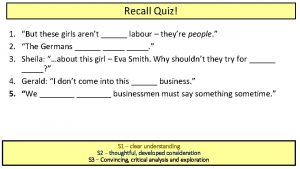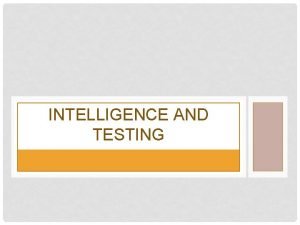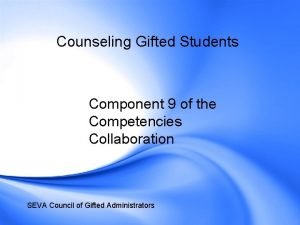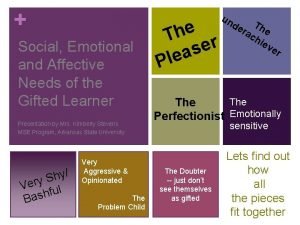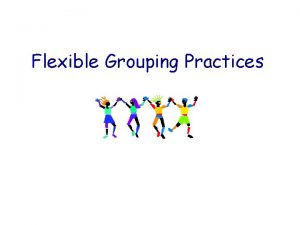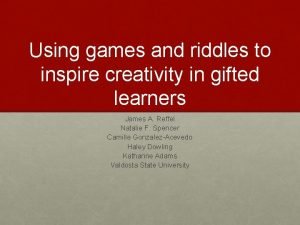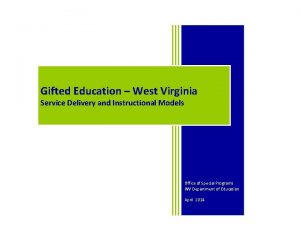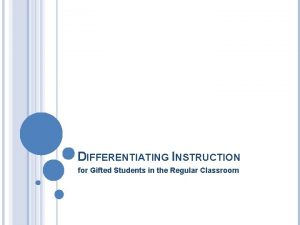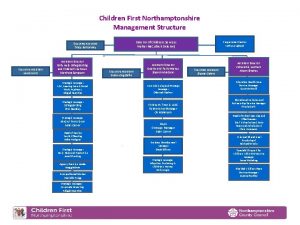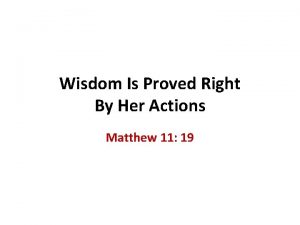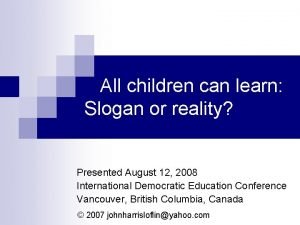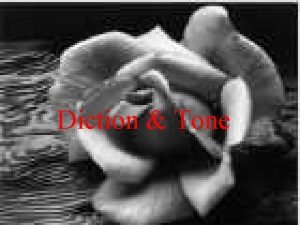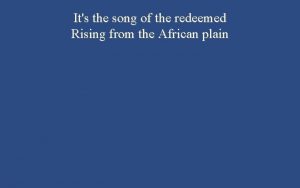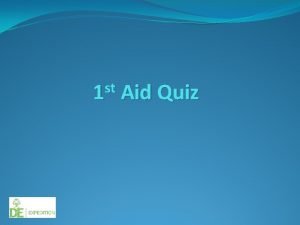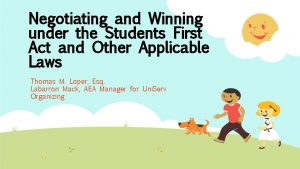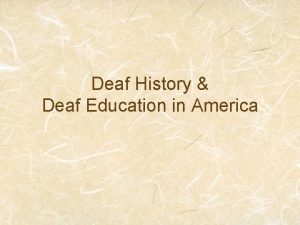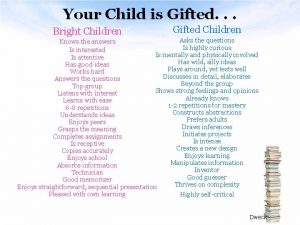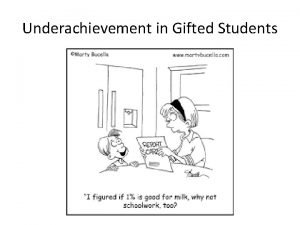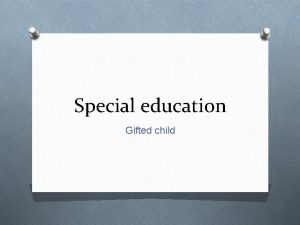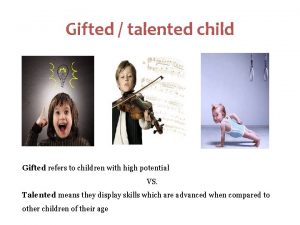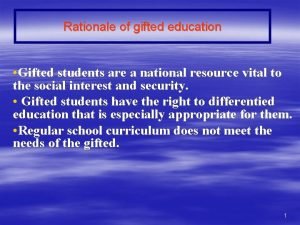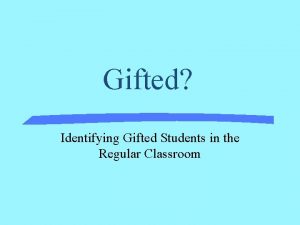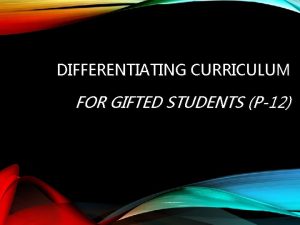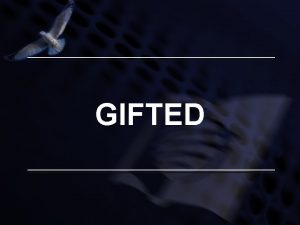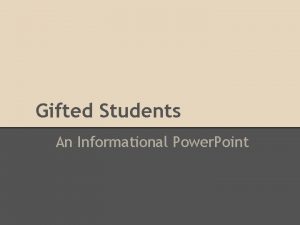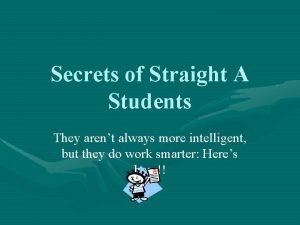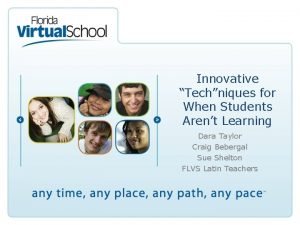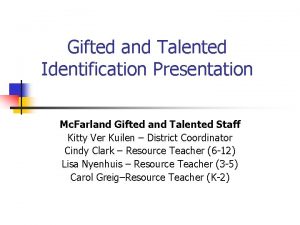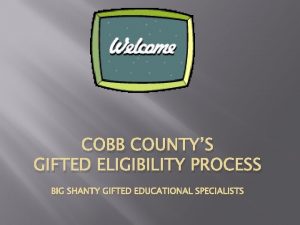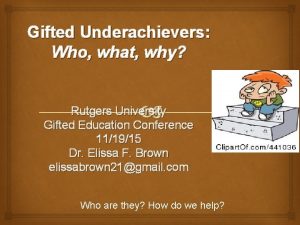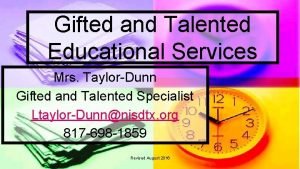Gifted Students Arent all children gifted The first





















- Slides: 21

Gifted Students

Aren’t all children gifted? • The first step is to desensitise the issue. • Labelling a child as gifted does not instil them with more worth than another child. • Identifying a child as gifted is identifying a need that must be addressed. • Gifted students learn differently to to their peers and will suffer if these needs are not met. Oakland, T 2005, ‘Assessment of Gifted Students for Identification Purposes: New Techniques for a New Millennium’, Learning and individual differences, vol. 20, no. 4, pp. 327 -36

What is giftedness? • Gagné cautions that it is important to differentiate between giftedness and talent. • Gifts are the “natural abilities” that can only become talents provided the right intrapersonal characteristics, environmental influences and luck! Gross M, et al. 2004, Gifted and Talented Education: Professional development package for teachers, Department of Education, Science and Training, Sydney, NSW

The Gagné Model of Giftedness and Talent

Characteristics of gifted students Cognitive Social / Emotional

Cognitive characteristics of gifted students • • • Fast pace of learning (dislike slow) Extremely well developed memory Preference for independent work Require deeper exploration of topic Ask reflective, probing questions Reason at a level beyond their years Gross M, Sleap B & Pretorius M, 1999, ‘Characteristics of gifted students’ in Gifted Students in Secondary Schools, GERRIC, Sydney, NSW

Characteristics of gifted students Cognitive Social / Emotional

Affective characteristics of gifted students • • • Experience intense emotions Exhibit perfectionist tendencies Highly developed sense of justice Empathy – unusually high or absent Very mature sense of humour Prefer company of older students Gross M, Sleap B & Pretorius M, 1999, ‘Characteristics of gifted students’ in Gifted Students in Secondary Schools, GERRIC, Sydney, NSW

Not all gifted students are the same Type I – The Successful Type IV – The Dropouts Type II – The Divergently Gifted Type V – The Double-labelled Type III – The Underground Type VI – The Autonomous Learner Betts GT & Neihart M 1988, ‘Profiles of the Gifted and Talented’, The Gifted Child Quarterly, vol. 32, no. 2, pp. 248 -253

Type I – The Successful • Account for approx. 90% of gifted students in school programs • Learned to work within the system • Behavioural problems rare as eager for approval • Become competent but uncreative adults that rarely achieve their full potential Betts GT & Neihart M 1988, ‘Profiles of the Gifted and Talented’, The Gifted Child Quarterly, vol. 32, no. 2, pp. 248 -253

Type II – The Divergently Gifted • Rarely identified and placed in program • Very creative but obstinate / tactless / sarcastic • Question authority, challenge teachers • Social problems – potential dropouts Betts GT & Neihart M 1988, ‘Profiles of the Gifted and Talented’, The Gifted Child Quarterly, vol. 32, no. 2, pp. 248 -253

Type III – The Underground • Mostly girls craving social inclusion • Will attempt to hide their gifts • More resistant the more they are pushed Betts GT & Neihart M 1988, ‘Profiles of the Gifted and Talented’, The Gifted Child Quarterly, vol. 32, no. 2, pp. 248 -253

Type IV – The Dropouts • Angry with parents and teachers for being failed by the system • Angry with themselves for being unable to work within the system • Rejected / depressed / withdrawn / aggressive Betts GT & Neihart M 1988, ‘Profiles of the Gifted and Talented’, The Gifted Child Quarterly, vol. 32, no. 2, pp. 248 -253

Type V – The Doublelabelled • Academic gifts coupled with physical or social/emotional disability • Most common counterpart is Asperger’s syndrome • Talents often masked – sometimes to the extent that they end up in remedial programs Betts GT & Neihart M 1988, ‘Profiles of the Gifted and Talented’, The Gifted Child Quarterly, vol. 32, no. 2, pp. 248 -253

Type VI – The Autonomous Learner • Independent and self-directed • They don’t work for the system but make it work for them • Create their own opportunities • Positive and successful • Often in leadership roles Betts GT & Neihart M 1988, ‘Profiles of the Gifted and Talented’, The Gifted Child Quarterly, vol. 32, no. 2, pp. 248 -253

The Identification Process Standardised achievement tests • Parent nomination • Teacher nomination • Student work Standardised test of giftedness Dynamic testing teachercreated assessments Program Placement Adjustment of curriculum Continual monitoring Above-/Off-level testing Oakland, T 2005, ‘A 21 st-Century model for identifying for gifted and talented programs in light of conditions: an emphasis on race and ethnicity’, Gifted Child Today, vol. 28, no. 4, pp. 56 -58

Issues • Identification is often very difficult in disadvantaged or culturally diverse populations • Failure to identify can result in anger, frustration, alienation, etc • Badly managed programs can also serve to alienate gifted students Hansen, JB & Johnston Toso, S 2007, ‘Gifted Dropouts: personality, family, social and school factors’, Gifted Child Today, vol. 30, no. 4, pp. 30 -41

Implications for learning • There are 3 main ways in which the curriculum should be differentiated • 1 – Process modifications • 2 – Product modifications • 3 – Learning environment Vaille, W & Geake, J 2003, ‘Pedagogy and Curriculum’ in W Vaille & J Geake (eds), The Gifted Enigma; a collection of articles, Hawker Brownlow Education, Cheltenham, VIC

Process Modifications • Learning tasks should be abstract, complex, varied • Learning tasks should involve issues of organisation, study of people, methods of inquiry. Vaille, W & Geake, J 2003, ‘Pedagogy and Curriculum’ in W Vaille & J Geake (eds), The Gifted Enigma; a collection of articles, Hawker Brownlow Education, Cheltenham, VIC

Product Modifications • • Involve higher order thinking processes Promote creative and critical thinking Require problem solving Involve group interaction Variable levels of pacing Allow for debriefing of the process Involve open-endedness Allow for freedom of choice. Vaille, W & Geake, J 2003, ‘Pedagogy and Curriculum’ in W Vaille & J Geake (eds), The Gifted Enigma; a collection of articles, Hawker Brownlow Education, Cheltenham, VIC

Learning Environment • • Flexible and open Encourage independent learning Accepting and non judgemental Encourage complex and abstract thought. Vaille, W & Geake, J 2003, ‘Pedagogy and Curriculum’ in W Vaille & J Geake (eds), The Gifted Enigma; a collection of articles, Hawker Brownlow Education, Cheltenham, VIC
 But these girls arent
But these girls arent Runion pronunciation
Runion pronunciation You are arent you
You are arent you Lewis terman
Lewis terman Gifted and talented learners in the philippines
Gifted and talented learners in the philippines Counseling strategies for gifted students
Counseling strategies for gifted students Affective needs of gifted students
Affective needs of gifted students Flexible grouping strategies
Flexible grouping strategies Patchwords puzzles
Patchwords puzzles Characteristics of gifted students
Characteristics of gifted students Differentiated instruction for gifted students
Differentiated instruction for gifted students Draw three noncollinear points j k and l
Draw three noncollinear points j k and l What image did rizal carved on a piece of batikuling
What image did rizal carved on a piece of batikuling Children first northamptonshire
Children first northamptonshire Wisdom is justified by her deeds
Wisdom is justified by her deeds Virtual reality slogans
Virtual reality slogans Diction refers to
Diction refers to Glory glory hallelujah he reigns
Glory glory hallelujah he reigns The song of the redeemed
The song of the redeemed Three ps in first aid
Three ps in first aid Students first act
Students first act First american school for the deaf
First american school for the deaf
